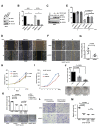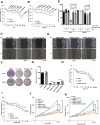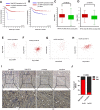Deficiency of BAP1 inhibits neuroblastoma tumorigenesis through destabilization of MYCN
- PMID: 37543638
- PMCID: PMC10404282
- DOI: 10.1038/s41419-023-06030-5
Deficiency of BAP1 inhibits neuroblastoma tumorigenesis through destabilization of MYCN
Abstract
The transcription factor MYCN is frequently amplified and overexpressed in a variety of cancers including high-risk neuroblastoma (NB) and promotes tumor cell proliferation, survival, and migration. Therefore, MYCN is being pursued as an attractive therapeutic target for selective inhibition of its upstream regulators because MYCN is considered a "undruggable" target. Thus, it is important to explore the upstream regulators for the transcription and post-translational modification of MYCN. Here, we report that BRCA1-associated protein-1 (BAP1) promotes deubiquitination and subsequent stabilization of MYCN by directly binding to MYCN protein. Furthermore, BAP1 knockdown inhibits NB tumor cells growth and migration in vitro and in vivo, which can be rescued partially by ectopic expression of MYCN. Importantly, depletion of BAP1 confers cellular resistance to bromodomain and extraterminal (BET) protein inhibitor JQ1 and Aurora A kinase inhibitor Alisertib. Furthermore, IHC results of NB tissue array confirmed the positive correlation between BAP1 and MYCN protein. Altogether, our work not only uncovers an oncogenic function of BAP1 by stabilizing MYCN, but also reveals a critical mechanism for the post-translational regulation of MYCN in NB. Our findings further indicate that BAP1 could be a potential therapeutic target for MYCN-amplified neuroblastoma.
© 2023. The Author(s).
Conflict of interest statement
The authors declare no competing interests.
Figures






References
Publication types
MeSH terms
Substances
LinkOut - more resources
Full Text Sources
Medical
Research Materials
Miscellaneous

